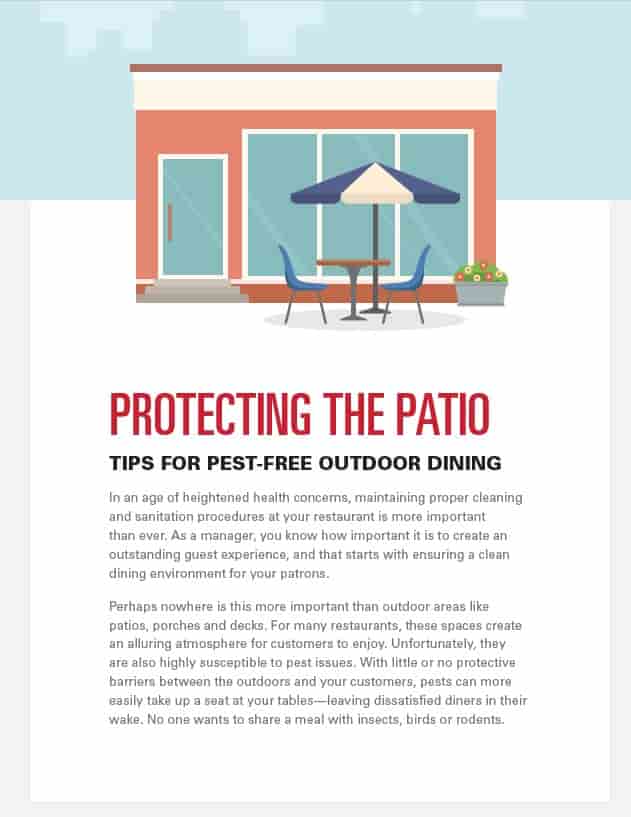In an age of heightened health concerns, maintaining proper cleaning and sanitation procedures at your restaurant is more important than ever. As a manager, you know how important it is to create an outstanding guest experience, and that starts with ensuring a clean dining environment for your patrons.
Perhaps nowhere is this more important than outdoor areas like patios, porches and decks. For many restaurants, these spaces create an alluring atmosphere for customers to enjoy. Unfortunately, they are also highly susceptible to pest issues. With little or no protective barriers between the outdoors and your customers, pests can more easily take up a seat at your tables—leaving dissatisfied diners in their wake. No one wants to share a meal with insects, birds or rodents.
Keep All Outdoor Dining Spaces as Clean As Possible
Keep all outdoor dining spaces as clean as possible, ensuring the floors are swept and tables wiped down after every shift. This includes hard-to-reach areas in corners and under the tables. Pests are attracted to food scraps, and any extra clutter left lying about provides them with more hiding places. A full deep clean should be performed every two weeks, at a minimum.
Clean Up Food & Water Spills Immediately
Clean up any food and water spills immediately, and clear tables quickly after customers exit. Accidents happen, but the sooner you can remove any exposed food sources, the less opportunities pests have to seek them out.
Place Waste Receptacles Away From The Dining Area
Place dumpsters and other garbage receptacles as far away from the dining area as possible, as any odorous refuse will attract pests. Be sure that the areas around these containers aren’t showing signs of leaks and that all lids are tightly sealed. It’s also a good idea to work with your waste management provider to set a regular pickup and dumpster rotation schedule.
Replace Your Lighting
Replace fluorescent lights with sodium vapor bulbs, which are less attractive to flies and other flying insects.
Maintain Landscaping Around Your Dining Areas
Ensure flower beds and landscaping around the building or adjacent to outdoor dining areas are well-maintained to eliminate harbourage for pests such as rodents, wasps or spiders. This includes ornamental plants as well, since potted plants can harbour soilburrowing insects like crickets and outdoor cockroaches. Avoid overwatering, as this can lead to small flies like fungus gnats and midges breeding and invading the dining areas.
Inspect Eaves & Flat Ledges For Nests
Inspect eaves, flat ledges and similar structures for wasp nests, spider webs and bird roosting spots. Where birds roost, they leave behind droppings and bird mites.
Seal Cracks & Crevices
Seal cracks and crevices in the floor to prevent pavement ants from foraging in the dining areas.
Check Wood Structures For Moisture
Check to ensure wood structures are not moisture-compromised, as this can attract carpenter ants.
Following these basic tips will provide a great start to ensuring a pest-free outdoor dining environment for your customers. In addition, talk to your pest management provider about setting up an Integrated Pest Management (IPM) program for your restaurant, which can help address more specific concerns. Your provider will examine the property and make detailed recommendations for pest exclusion, prevention and treatment. It’s the best way to remain confident that your restaurant is protected from pests, no matter the season or circumstances.
Need a quick reference guide for all of this? You can also download our expert tip sheet here.

You may also like
Canada's Top 25 Bed Bug Cities Of 2023
Bed bugs are extremely efficient hitch hikers. They can move easily across a room and climb onto luggage or anything left on a bed in just one night. Learn which cities have made Canada’s top 25 bed buggiest cities.
British Columbia's Top 20 'Rattiest' Cities 2023
As winter approaches, pest control leader Orkin Canada reminds homeowners and business owners to take precautions to help keep rodents out. Cities are ranked by the number of rodent (rat & mice) treatments the company performed from August 1, 2021 through July 31, 2022.
Ontario's Top 25 "Rattiest" Cities 2023
Pest control leader Orkin Canada reminds home owners and business owners to take precautions to help keep rodents out. Cities are ranked by the number of rodent (rat & mice) treatments the company performed from August 1, 2022 through July 31, 2023. This ranking includes both residential and commercial treatments.
Eastern Canada's Top 15 'Rattiest' Cities 2023
As winter approaches, pest control leader Orkin Canada reminds homeowners and business owners to take precautions to help keep rodents out. Cities are ranked by the number of rodent (rat & mice) treatments the company performed from August 1, 2021 through July 31, 2022.
Remove pests from your business, and stop them from coming back
We work hard to listen, understand and assess your unique situation. Request a free, no-obligation consultation today for a customized pest program that fits your needs.
Request a Free Business ConsultationRequest a Free Home Estimate


